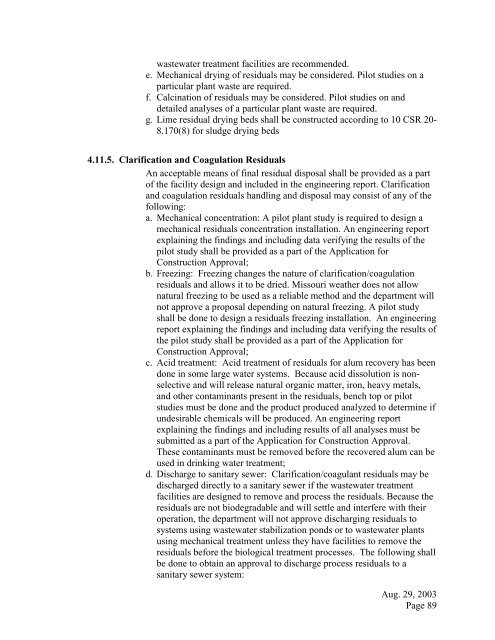Design Guide for Community Water Systems - The Water, Sanitation ...
Design Guide for Community Water Systems - The Water, Sanitation ...
Design Guide for Community Water Systems - The Water, Sanitation ...
You also want an ePaper? Increase the reach of your titles
YUMPU automatically turns print PDFs into web optimized ePapers that Google loves.
wastewater treatment facilities are recommended.e. Mechanical drying of residuals may be considered. Pilot studies on aparticular plant waste are required.f. Calcination of residuals may be considered. Pilot studies on anddetailed analyses of a particular plant waste are required.g. Lime residual drying beds shall be constructed according to 10 CSR 20-8.170(8) <strong>for</strong> sludge drying beds4.11.5. Clarification and Coagulation ResidualsAn acceptable means of final residual disposal shall be provided as a partof the facility design and included in the engineering report. Clarificationand coagulation residuals handling and disposal may consist of any of thefollowing:a. Mechanical concentration: A pilot plant study is required to design amechanical residuals concentration installation. An engineering reportexplaining the findings and including data verifying the results of thepilot study shall be provided as a part of the Application <strong>for</strong>Construction Approval;b. Freezing: Freezing changes the nature of clarification/coagulationresiduals and allows it to be dried. Missouri weather does not allownatural freezing to be used as a reliable method and the department willnot approve a proposal depending on natural freezing. A pilot studyshall be done to design a residuals freezing installation. An engineeringreport explaining the findings and including data verifying the results ofthe pilot study shall be provided as a part of the Application <strong>for</strong>Construction Approval;c. Acid treatment: Acid treatment of residuals <strong>for</strong> alum recovery has beendone in some large water systems. Because acid dissolution is nonselectiveand will release natural organic matter, iron, heavy metals,and other contaminants present in the residuals, bench top or pilotstudies must be done and the product produced analyzed to determine ifundesirable chemicals will be produced. An engineering reportexplaining the findings and including results of all analyses must besubmitted as a part of the Application <strong>for</strong> Construction Approval.<strong>The</strong>se contaminants must be removed be<strong>for</strong>e the recovered alum can beused in drinking water treatment;d. Discharge to sanitary sewer: Clarification/coagulant residuals may bedischarged directly to a sanitary sewer if the wastewater treatmentfacilities are designed to remove and process the residuals. Because theresiduals are not biodegradable and will settle and interfere with theiroperation, the department will not approve discharging residuals tosystems using wastewater stabilization ponds or to wastewater plantsusing mechanical treatment unless they have facilities to remove theresiduals be<strong>for</strong>e the biological treatment processes. <strong>The</strong> following shallbe done to obtain an approval to discharge process residuals to asanitary sewer system:Aug. 29, 2003Page 89
















